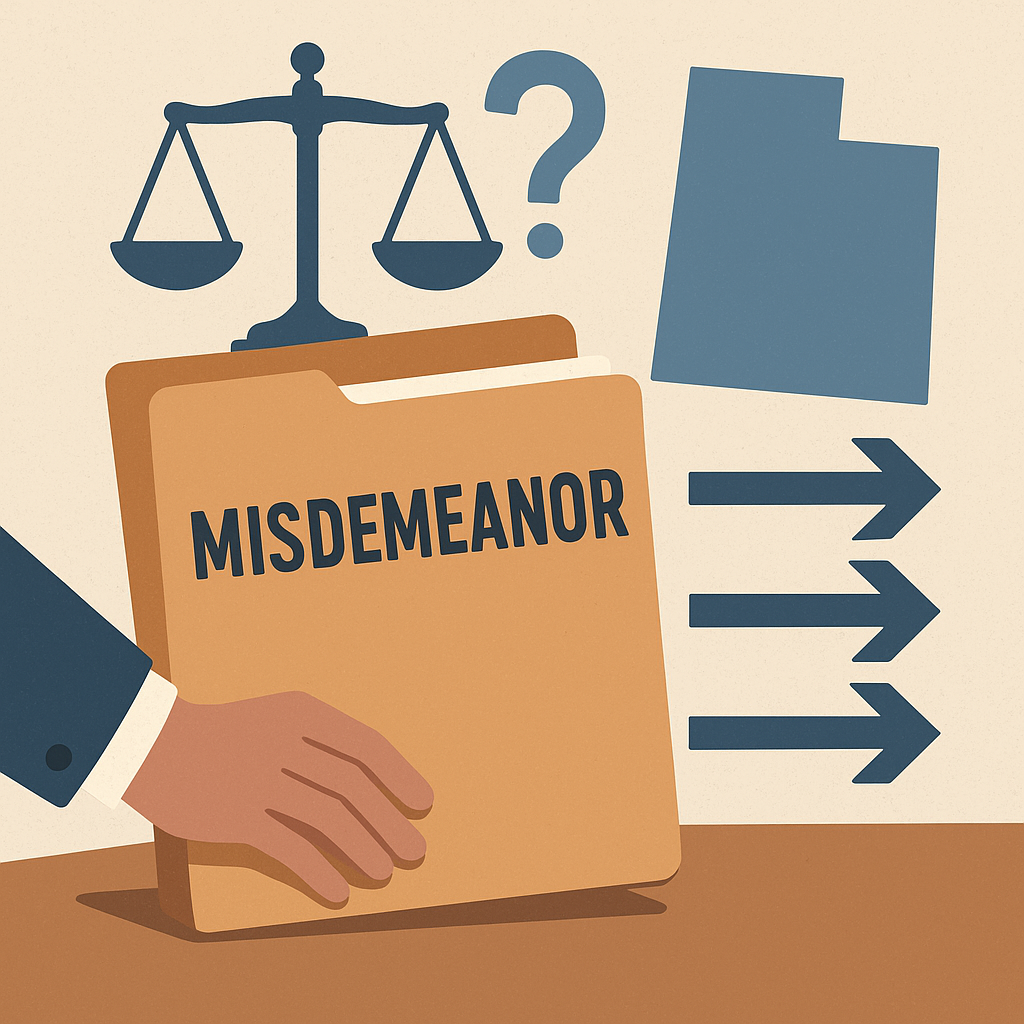What are my options after a Utah misdemeanor charge? A step-by-step roadmap you can follow
A plain-English guide to charge levels, plea choices, diversion, sentencing, collateral consequences, and expungement
A misdemeanor in Utah is serious, but you have choices. The outcome does not just depend on the charge itself – it also depends on the decisions you make in the days and weeks after being cited.
This guide explains what a misdemeanor means under Utah law, the plea and diversion options that may be available, what sentencing could look like, and how to limit long-term damage through expungement.
With a clear roadmap, you will know what to expect, how to protect yourself, and where to find reliable next steps.
Step 1 – Understand the Charge Level
Utah misdemeanors come in three classes. Your class drives the maximum jail exposure and fines, and it frames plea talks and sentencing.
Class A
Most serious misdemeanor. Up to 364 days in jail and up to 2,500 dollars in fines.
Class B
Up to 6 months in jail and up to 1,000 dollars in fines.
Class C
Up to 90 days in jail and up to 750 dollars in fines.
Why it matters
Knowing your class helps you and your lawyer target defenses, diversion, or abeyance and set realistic outcomes.
Step 2 – Review Your Plea Options
At arraignment or soon after, you will enter a plea. Each choice has ripple effects for your record and leverage.
Guilty
Admit the charge and go to sentencing. Often paired with a negotiated recommendation.
No Contest
Do not admit guilt but accept conviction. Treated like guilty for sentencing.
Not Guilty
Contest the charge. Preserves defenses and pushes the case toward motions and trial.
Plea in Abeyance
You enter a plea, but the court holds it. Complete conditions like classes, community service, or restitution and the case may dismiss instead of showing as a conviction.
Tip: Ask early about abeyance eligibility for first-time or low-level cases. Timing matters.
Step 3 – Ask About Diversion Programs
Diversion is a deal with the prosecutor or court where you complete requirements in exchange for dismissal.
- Common requirements – classes, counseling or treatment, community service, and staying citation free.
- Best for – first-time or low-level offenses and cases with treatment needs.
- Upside – avoids a conviction and can speed up expungement.
Reminder: Every county and court has its own approach. Ask what exists in your courthouse.
Step 4 – Prepare for Sentencing
Outcomes depend on the class, your record, and facts. Judges often favor alternatives to jail for lower-level cases if you show accountability.
- Jail time – frequently suspended in favor of probation for low-level cases.
- Probation conditions – fines, community service, treatment, classes, no new offenses.
- Financial obligations – fines, surcharges, fees, and restitution where there is loss.
Practical step: Bring proof of work or school, treatment enrollment, or restitution planning. It can improve results.
Step 5 – Understand Collateral Consequences
A conviction can reach beyond the courtroom. Think about the long game before you choose a plea.
- Jobs and background checks.
- Housing applications.
- Professional or trade licenses.
- Immigration consequences if you are not a United States citizen.
- Driving privileges for charges like DUI.
Bottom line: Ask your lawyer to flag hidden impacts tied to your specific charge.
Step 6 – Explore Expungement Options
Many Utah misdemeanors can be cleared from your record. Waiting periods vary by class and outcome. Utah Clean Slate also clears certain low-level cases automatically after time passes.
Why it matters: Clearing your record helps with jobs, housing, loans, and peace of mind.
Action item: After the case ends, calendar your eligibility date and gather your case number, docket, and proof of completion for the expungement packet.
Video and Instagram Resources
YouTube
Key Takeaways
Act early – ask about diversion or plea in abeyance if you qualify. Timing affects eligibility.
Sentencing is not just jail or fines. Strong mitigation can shift outcomes to probation and classes.
Plan for expungement as part of your case strategy to limit long-term damage.
This page is legal information, not legal advice. Talk with a Utah lawyer about your exact facts.
Next Step
Review your charge level, map your plea options, and ask about diversion or abeyance. If you are past sentencing, check expungement timing now.
Talk to a Utah Criminal Defense LawyerA short consult can help you spot defenses, protect your record, and set up expungement on day one.
For more plain-English legal guidance, stay updated with Utah Law Explained, explore our mission on the About Us page, or connect with trusted counsel like Gibb Law Firm.
